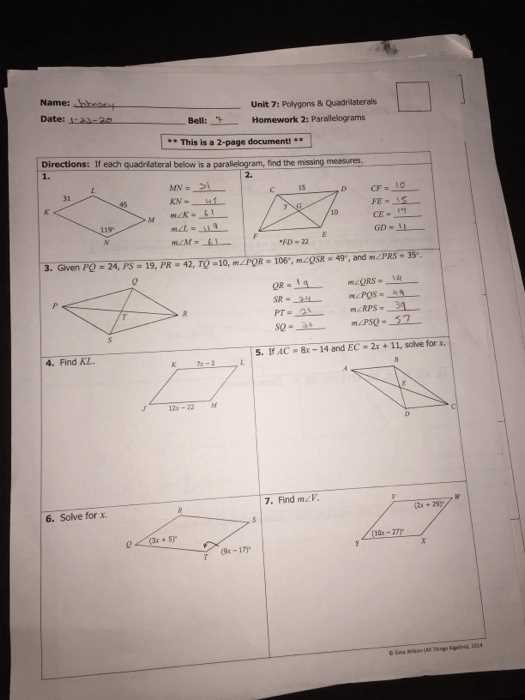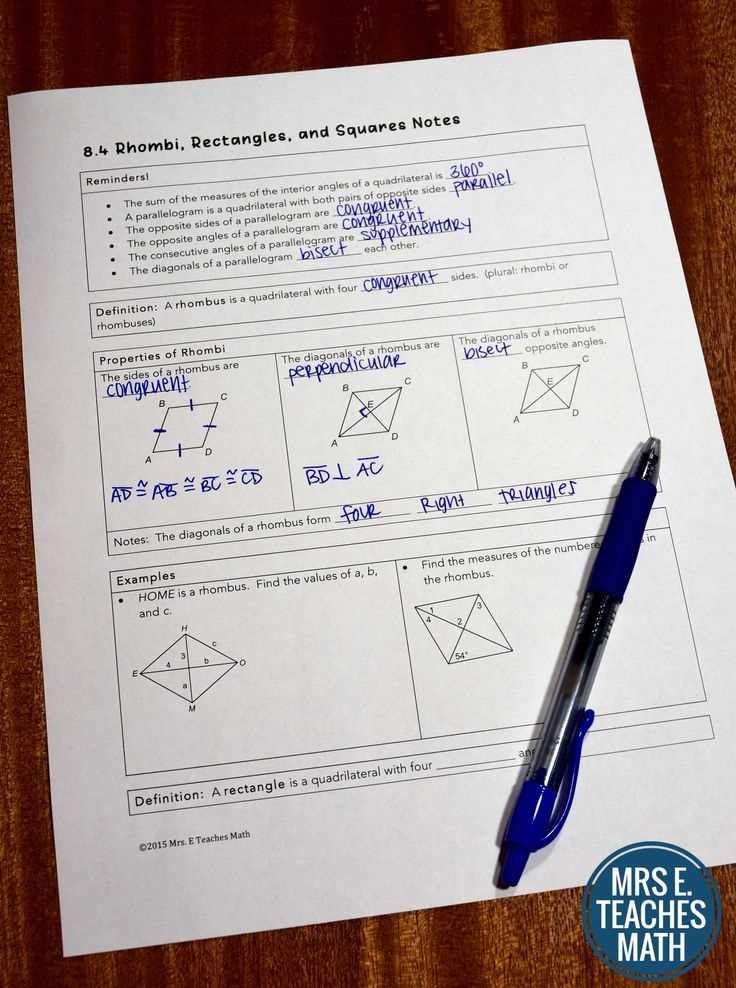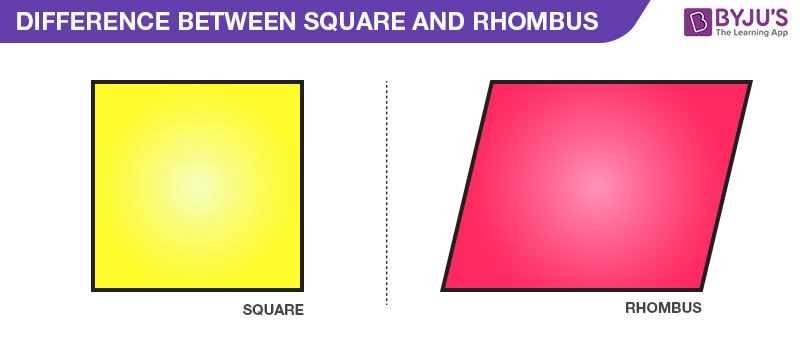
Your geometry skills are about to be put to the test with these rhombi and squares! In this article, we will delve into the key concepts and practice problems related to these two geometric figures. By understanding the properties and characteristics of rhombi and squares, you will be able to confidently solve problems involving their various attributes and measurements.
We will begin by exploring the definitions and properties of rhombi and squares. A rhombus is a quadrilateral with all four sides of equal length. In addition, its opposite angles are congruent, making it a type of parallelogram. A square, on the other hand, is a special type of rhombus where all angles are right angles, and all sides are of equal length. Both rhombi and squares possess numerous unique properties that set them apart from other polygons.
Once you have a solid understanding of the definitions and properties, we will move on to practicing problems related to rhombi and squares. These practice problems will cover a range of topics, including calculating side lengths and angles, finding areas and perimeters, and identifying diagonals and other internal elements. By actively solving these problems, you will reinforce your knowledge and develop a deeper comprehension of how to apply the concepts to real-world situations.
By completing this practice, you will gain a comprehensive understanding of rhombi and squares, and be well-prepared to tackle more complex geometry problems. So, let’s dive in and master the world of rhombi and squares!
Step-by-step instructions for solving practice problems
When it comes to solving practice problems, following a step-by-step approach can greatly improve your chances of finding the correct answers. Whether you’re working on problems related to rhombi and squares or any other topic, the following guidelines will help you navigate through the process:
- Read the problem carefully: In order to effectively solve a practice problem, it’s crucial to fully understand the given information. Pay attention to any important details, measurements, or specific instructions provided.
- Identify the key concepts: Once you have a clear understanding of the problem, identify the main concepts or formulas that are relevant to the topic at hand. In the case of rhombi and squares, this may include properties and characteristics specific to these shapes.
- Visualize the problem: It can be helpful to sketch a diagram or draw a representation of the given problem. This visual aid will assist you in visualizing the information and better understanding the relationships between different elements.
- Apply the appropriate formula or method: Use the identified formulas or methods to solve the problem step by step. Make sure to substitute the given values into the formula correctly and perform the necessary mathematical operations.
- Show your work: It is important to show all your calculations and steps involved in solving the problem. This will not only help you keep track of your progress, but also make it easier to identify any mistakes or errors along the way.
- Check your answer: Once you have obtained a solution, take the time to verify whether it makes sense in the context of the problem. You can do this by re-reading the problem and ensuring that your answer aligns with the given information.
By following these step-by-step instructions, you’ll be able to approach practice problems with confidence and increase your chances of finding the correct answers. Remember, practice makes perfect, so don’t hesitate to tackle as many problems as you need to strengthen your problem-solving skills.
Identifying properties of rhombi and squares
Rhombi and squares are special types of quadrilaterals that possess unique properties. By understanding these properties, we can easily identify and classify these shapes.
Rhombus properties:
- A rhombus is a quadrilateral with all sides of equal length.
- The opposite angles of a rhombus are congruent.
- The diagonals of a rhombus bisect each other at right angles.
- The sum of the squares of the diagonals is equal to the sum of the squares of the sides.
- A rhombus has two pairs of parallel sides.
Square properties:
- A square is a special type of rhombus where all angles are right angles.
- All sides of a square are congruent.
- The diagonals of a square are equal in length and bisect each other at right angles.
- A square has four pairs of parallel sides.
- The perimeter of a square is equal to four times the length of its side.
By recognizing these key properties, we can easily determine whether a given quadrilateral is a rhombus or a square. These properties also help us understand the relationships between the sides, angles, and diagonals of these shapes.
Applying the properties to solve problems
When working with rhombi and squares, it is important to understand and apply their properties in order to solve various problems. One key property of a rhombus is that all four sides are congruent, meaning they have the same length. This property allows us to determine missing side lengths or solve for unknown angles in a rhombus. By using the concept of congruence, we can set up equations and solve for the missing values.
Another important property of a square is that it has four right angles. This property can be used to solve problems involving the angles of a square. For example, if we know the measure of one angle in a square, we can determine the measures of all the other angles by applying the property of right angles. This can be helpful when solving problems related to the interior angles of a square or finding the measures of angles in a figure that includes squares.
Additionally, the diagonals of a rhombus and square have some special properties that can be applied to solve problems. In a rhombus, the diagonals are perpendicular bisectors of each other, meaning they intersect at a right angle and divide each other into two equal parts. This property can be used to find the lengths of the diagonals or the measures of angles formed by the diagonals. In a square, the diagonals are not only perpendicular bisectors, but they are also congruent. This means that the diagonals of a square have the same length and divide each other into two equal parts. These properties can be applied to solve various types of problems involving the diagonals of rhombi and squares.
Example Questions and Solutions
In this section, we will go over some example questions related to rhombi and squares and provide their solutions. These questions will help you better understand the concepts and properties of these geometric shapes.
Question 1:
Find the area of a rhombus with diagonals measuring 8 cm and 10 cm.
Solution:
To find the area of a rhombus, we can use the formula A = (d1 * d2) / 2, where d1 and d2 are the lengths of the diagonals. Plugging in the given values, we get A = (8 cm * 10 cm) / 2 = 40 cm². Therefore, the area of the rhombus is 40 square centimeters.
Question 2:
A square has a side length of 5 inches. Find its perimeter.
Solution:
The formula to find the perimeter of a square is P = 4s, where s represents the length of each side. Plugging in the given value, we have P = 4 * 5 inches = 20 inches. Therefore, the perimeter of the square is 20 inches.
Question 3:
A rhombus has diagonals with lengths of 12 meters and 16 meters. Find the length of each side.
Solution:
In a rhombus, all four sides are congruent. To find the length of each side, we can use the formula s = √(d1² + d2²) / 2, where d1 and d2 are the lengths of the diagonals. Plugging in the given values, we get s = √(12 meters)² + (16 meters)²) / 2 = √(144 meters² + 256 meters²) / 2 = √(400 meters²) / 2 = √400 meters² / 2 = 20 meters / 2 = 10 meters. Therefore, each side of the rhombus measures 10 meters.
These examples demonstrate how to apply the formulas and properties of rhombi and squares to solve various problems. By practicing more questions and understanding the concepts, you will become more proficient in working with these geometric shapes.
Example Question 1
In this example question, we are given a rhombus with side length 6 units and a square with side length 5 units. We are asked to calculate the area of each figure.
To find the area of a rhombus, we can use the formula A = (d1 * d2) / 2, where d1 and d2 are the lengths of the diagonals. In a rhombus, the diagonals are perpendicular bisectors of each other, which means they intersect at a right angle. Since the side length is given as 6 units, we can use the Pythagorean theorem to find the length of the diagonals.
We know that the right triangle formed by one of the diagonals and half of a side is a 30-60-90 triangle, where the hypotenuse is twice the length of the shorter leg. In this case, the shorter leg is half of the side length, which is 3 units. So the length of the diagonal can be found as follows:
- Shorter leg = 3 units
- Hypotenuse = 2 * shorter leg = 2 * 3 = 6 units
- Longer leg = sqrt(hypotenuse^2 – shorter leg^2) = sqrt(6^2 – 3^2) = sqrt(36 – 9) = sqrt(27) = 3 * sqrt(3) units
Now that we have the length of the diagonals, we can substitute into the formula to find the area of the rhombus. Plugging in d1 = 6 units and d2 = 3 * sqrt(3) units, we have:
A = (6 * (3 * sqrt(3))) / 2 = 9 * sqrt(3) square units
Next, we need to find the area of the square. The formula to find the area of a square is simply A = side^2. In this case, the side length is given as 5 units, so we can calculate the area as follows:
A = 5^2 = 25 square units
So, the area of the rhombus is 9 * sqrt(3) square units and the area of the square is 25 square units.
Solution to example question 1
The question states that we need to find the area of a rhombus with side length 8 cm. The formula for the area of a rhombus is given as 1/2 times the product of the diagonals, so we need to find the lengths of the diagonals first.
Since all sides of a rhombus are congruent, we can use the Pythagorean theorem to find the lengths of the diagonals. Let’s label one of the diagonals as “d1” and the other as “d2”.
- The length of one side of the rhombus is given as 8 cm.
- By the Pythagorean theorem, the length of each diagonal can be found as √(82 + 82) = √(64 + 64) = √128 cm.
Now that we know the lengths of the diagonals, we can calculate the area of the rhombus. Plugging the values into the formula, we get 1/2 times (√128 cm) times (√128 cm) = 1/2 times 128 cm = 64 cm2.
Therefore, the area of the rhombus with side length 8 cm is 64 square centimeters.
Example question 2
In this example question, we are given a rhombus with diagonals of lengths 8 and 10 units. We are asked to find the side length and the area of the rhombus. Let’s start by analyzing the given information.
From the properties of a rhombus, we know that the diagonals of a rhombus bisect each other at a right angle. Therefore, we can form two right triangles inside the rhombus by drawing the perpendiculars from the vertices to the diagonals. Since the diagonals are perpendicular and bisect each other, these two right triangles will be congruent.
Let’s label the side length of the rhombus as ‘s’. From the given information, we know that the lengths of the diagonals are 8 units and 10 units. Using the Pythagorean theorem, we can find the side length ‘s’ by applying it to one of the right triangles.
Given: Diagonals of rhombus: 8 units and 10 units.
| Step | Calculation | Result |
|---|---|---|
| 1 | Using Pythagorean theorem: s² = (8/2)² + (10/2)² | s² = 16 + 25 = 41 |
| 2 | Taking square root of both sides: s = √41 ≈ 6.40 | s ≈ 6.40 |
So, the side length of the rhombus is approximately 6.40 units. To find the area of the rhombus, we can use the formula: area = (diagonal₁ * diagonal₂) / 2. Plugging in the given values, we get:
- Area = (8 * 10) / 2 = 40 square units
Therefore, the area of the rhombus is 40 square units.
Solution to example question 2

In this example, we are given a rhombus with side length 8 units and find the perimeter of the rhombus.
Since we know that a rhombus has all four sides equal in length, we can simply multiply the side length by 4 to find the perimeter. In this case, the perimeter of the rhombus would be 8 units x 4 = 32 units.
Common Mistakes to Avoid
When working on problems related to rhombi and squares, there are some common mistakes that students often make. Here are a few of them to be aware of:
1. Confusing rhombi with squares

One mistake that students frequently make is mixing up rhombi and squares. It’s important to remember that while all squares are rhombi, not all rhombi are squares. A square is a special type of rhombus with equal sides and right angles. Make sure to carefully analyze the given information and identify the correct shape before proceeding with the problem.
2. Forgetting to check for additional properties
Another common mistake is forgetting to check for additional properties or relationships between the sides and angles. For example, in a rhombus, opposite angles are congruent, and the diagonals bisect each other at right angles. Missing these additional properties can lead to incorrect solutions or conclusions. Take the time to thoroughly analyze the given information and consider all relevant properties before solving the problem.
3. Failing to use the appropriate formulas
Using the wrong formulas or equations is another mistake that students often make. Each problem may require different formulas depending on the given information and what needs to be solved. It’s crucial to understand the relevant formulas for finding the perimeter, area, or angles of rhombi and squares and apply them correctly. Take the time to review and familiarize yourself with the appropriate formulas before attempting the problem.
Avoiding these common mistakes can greatly improve your success rate when working on problems related to rhombi and squares. By carefully analyzing the given information, checking for additional properties, and using the appropriate formulas, you can confidently solve these types of problems.